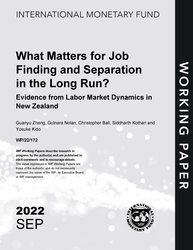
What Matters for Job Finding and Separation in the Long Run? Evidence from Labor Market Dynamics in New Zealand
What Matters for Job Finding and Separation in the Long Run? Evidence from Labor Market Dynamics in New Zealand
READ MORE...
Volume/Issue:
Volume 2022
Issue 172
Publication date: September 2022
ISBN: 9798400218910
$20.00
Add to Cart by clicking price of the language and format you'd like to purchase
Available Languages and Formats
| English |
Prices in red indicate formats that are not yet available but are forthcoming.
Topics covered in this book
This title contains information about the following subjects.
Click on a subject if you would like to see other titles with the same subjects.
Labor , Economics- Macroeconomics , Economics / General , Demography , Labor market dynamics , Gross worker flows , Unemployment variability , separation rate difference , separation rate , job finding , Non-employment rate , Labor markets , Unemployment rate , Labor force , Aging , Global
Summary
We use the novel anonymized Household Labour Force Survey (HLFS) microdata to analyze job finding rates and job separation rates in New Zealand. We find that individual characteristics, including age, gender, ethnicity and education have a significant impact on job finding and separation rates, even after controlling for other factors. We use a decomposition approach to analyze how the effects of individual characteristics on job finding and separation rates contribute to heterogeneity in employment outcomes. Overall, we find that higher separation rates of young workers play a disproportionate role in explaining heterogeneity of employment outcomes across age groups, while differences in finding rates are somewhat more important in explaining differences by education level. Both finding and separation rate differences are important in explaining differences across ethnicities. We also find some heterogeneous response of worker groups to business cycle after controlling for other factors. The results underscore the importance of well-targeted labor market support policies.
Copyright © 2010 - 2025
Powered by:
AIDC



